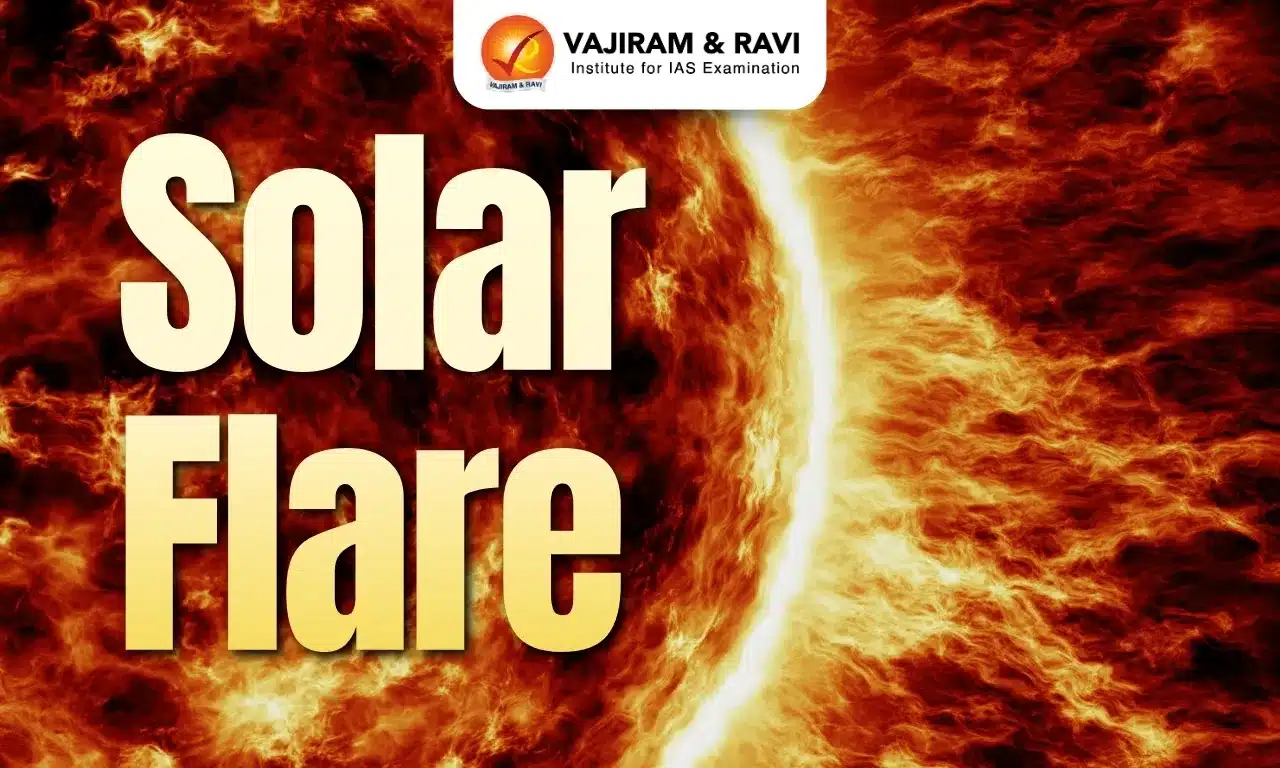Solar Flare Latest News
A huge sunspot that is more than 10 times bigger than Earth recently appeared on the surface of the sun, and scientists say it could lead to several strong solar flares in the coming weeks.
About Solar Flare
- A solar flare is an intense burst of radiation coming from the release of magnetic energy associated with sunspots.
- A flare appears as a sudden, intense brightening of a region on the Sun, lasting several minutes to hours.
- Flares occur when intense magnetic fields on the Sun become too tangled.
- Like a rubber band that snaps when it is twisted too far, the tangled magnetic fields release energy when they snap.
- The energy emitted by a solar flare is more than a million times greater than the energy from a volcanic eruption on Earth.
- Flares are our solar system’s largest explosive events.
- In a matter of just a few minutes, they heat the material to many millions of degrees and produce a burst of radiation across the electromagnetic spectrum, including from radio waves to x-rays and gamma rays.
- Although solar flares can be visible in white light, they are often more readily noticed via their bright X-ray and ultraviolet emissions.
- The biggest flares occur in association with large sunspots that have sharp magnetic gradients and large currents, which are the source of the flare energy.
- Solar flares burst forth from intense magnetic fields in the vicinity of active regions on the Sun and are most common during times of peak solar activity.
- Coronal mass ejections often accompany solar flares, though scientists are still trying to determine exactly how the two phenomena are related.
- Effect of Solar Flare on Earth:
- The intense radiation emitted during a solar flare can affect satellite communications, disrupt radio signals, and even pose a risk to astronauts in space.
- Additionally, the increased solar radiation can lead to geomagnetic storms, which may impact power grids and cause auroras (northern and southern lights) at lower latitudes.
What are Sunspots?
- Sunspots are areas that appear dark on the surface of the Sun.
- They appear dark because they are cooler than other parts of the Sun’s surface.
- Why are sunspots relatively cool?
- It’s because they form in areas where magnetic fields are particularly strong.
- These magnetic fields are so strong that they keep some of the heat within the Sun from reaching the surface.
Source: NDTV
Last updated on November, 2025
→ Check out the latest UPSC Syllabus 2026 here.
→ Join Vajiram & Ravi’s Interview Guidance Programme for expert help to crack your final UPSC stage.
→ UPSC Mains Result 2025 is now out.
→ UPSC Notification 2026 is scheduled to be released on January 14, 2026.
→ UPSC Calendar 2026 is released on 15th May, 2025.
→ The UPSC Vacancy 2025 were released 1129, out of which 979 were for UPSC CSE and remaining 150 are for UPSC IFoS.
→ UPSC Prelims 2026 will be conducted on 24th May, 2026 & UPSC Mains 2026 will be conducted on 21st August 2026.
→ The UPSC Selection Process is of 3 stages-Prelims, Mains and Interview.
→ UPSC Result 2024 is released with latest UPSC Marksheet 2024. Check Now!
→ UPSC Prelims Result 2025 is out now for the CSE held on 25 May 2025.
→ UPSC Toppers List 2024 is released now. Shakti Dubey is UPSC AIR 1 2024 Topper.
→ UPSC Prelims Question Paper 2025 and Unofficial Prelims Answer Key 2025 are available now.
→ UPSC Mains Question Paper 2025 is out for Essay, GS 1, 2, 3 & GS 4.
→ UPSC Mains Indian Language Question Paper 2025 is now out.
→ UPSC Mains Optional Question Paper 2025 is now out.
→ Also check Best IAS Coaching in Delhi
Solar Flare FAQs
Q1. What causes a solar flare to occur?+
Q2. Solar flares usually emerge from which regions on the Sun?+
Q3. What impact can intense solar flares have on Earth?+
Q4. What effect can solar flare activity have on power grids on Earth?+
Tags: prelims pointers solar flare upsc current affairs upsc prelims current affairs

















